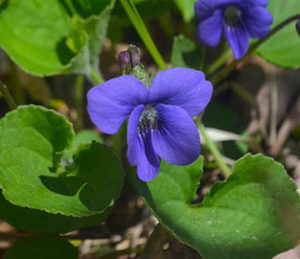We all have different aesthetic views. That’s part of what keeps all of our gardens interesting and makes them uniquely our own. Some of us like our beds to be very neatly maintained with expanses of wood mulch separating out each group of plants. Others like to use gravel to segregate their plantings. While still others, like to plant everything so closely together that there is no room or need for wood chips or gravel to keep the weeds out.
I tend heavily towards the philosophy of “leave no room for weeds and skip the mulch.” But that strategy doesn’t work everywhere or in all situations, even in my own gardens. Between stepping stones on a path or in the early spring before my late-season perennials have come back are just a couple of examples where I feel like “something” is needed. Over the years, I’ve started to gravitate towards a living green mulch or groundcover for these situations.
The type of living green mulch or groundcover you chose is going to depend greatly on the situation. Is it going to be in full sun all season because it is separating clumps of plants? Or is it going to get mostly shaded out by taller plants as the season progresses? Other site considerations will also come into play such as soil moisture, preferred height, flowering times (if any), etc.

You also want to consider how aggressive your living green mulch / groundcover is compared to the other plants in the bed. Ideally, you will want to pick a living green mulch that spreads enough to fill in the places that you want to fill in, but won’t take over and crowd out the other plants that you want. That can sometimes be a tricky balance to find. Unfortunately, like with most other things in the gardening world (or any other world for that matter) there is no single “right” answer for all of us.
To pick the right living green mulch / groundcover for your garden beds, I suggest a combination of two approaches. First, ask others with similar gardening interests and goals who live in your same general area what they use in their own gardens. That might give you some good options to consider. At the very least, it might help you sift through the options, which is always helpful because many of us struggle with information overload. If you don’t personally know anyone to ask, try your state’s native plant society. Native plant society’s often have lots of members who are interested in gardening with native plants.
Second, pay attention to what already tries to grow in the “empty” places of your garden. Granted, often times, those plants won’t be terribly helpful, but occasionally you’ll find a hidden gem. For instance, violets love my yard and my garden. They seem to pop up everywhere. I never really thought about using violets as a living green mulch / groundcover before moving to our current home several years ago, but now they are my favorite option.
The benefit of using a living green mulch / groundcover over wood chips or mulch is the additional ecological services they provide. Using my violets as an example, not only are they pretty and help keep other less desirable plants out, but they also provide nectar for a variety of small pollinators, are the host plant for the great spangled fritillary caterpillars, and are the only source of pollen eaten by the larva of one of our mining bees. To me, those are all wins.
A living green mulch or groundcover may not suit your gardening style or needs. Again, we all have unique goals and situations. But if you haven’t considered that option, then I encourage you to think about whether a living green mulch / groundcover might work in your garden. If you already use a living green mulch / ground cover, then please let me know what it is and where you are located. I’m always looking for new options to consider for myself or to offer as suggestions to others who ask me about them.

Backyard Ecology: Exploring Nature in Your Backyard
Nature isn’t just “out there.” It’s all around us, including right outside our doors. Hi, my name is Shannon Trimboli, and I am the host of Backyard Ecology. I live in southcentral Kentucky and am a wildlife biologist, educator, author, beekeeper, and owner of a nursery specializing in plants for pollinators and wildlife conservation. I invite you to join me as we ignite our curiosity and natural wonder, explore our yards and communities, and improve our local pollinator and wildlife habitat. Learn more or subscribe to my email list at www.backyardecology.net.

Leave a Reply